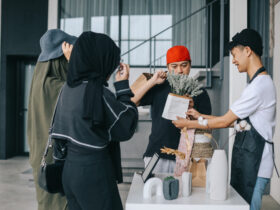In the growing landscape of the gaming industry, a new trend is reshaping how companies approach marketing: collaborative strategies that mirror the teamwork seen in multiplayer games.
Just as players join forces to conquer virtual worlds, game developers and publishers are now uniting their efforts to navigate the competitive realm of game promotion and sales.
This article delves into the innovative world of collaborative marketing within the gaming sector, exploring how industry players are breaking away from traditional, siloed approaches. We’ll examine the driving forces behind this shift, from the increasing complexity of the gaming market to the growing demands of a discerning player base.
The Rise of Collaborative Marketing in Gaming
The gaming industry has long been an area of innovation, consistently pushing the boundaries of technology and creativity. This spirit of innovation has now spread throughout marketing, driven by the increasing saturation of the market and the rising costs of player acquisition.
In response to these challenges, gaming companies are discovering that collaboration can be a potent tool for cutting through the noise of a crowded marketplace and reaching new audiences in meaningful ways.
The multiplayer approach to marketing offers a multitude of benefits that address the complex needs of modern gaming companies. By expanding reach, companies can tap into each other’s fan bases, exponentially increasing their potential audience. This strategy allows smaller or newer companies to gain exposure to established player communities, while larger companies can stay relevant by associating with up-and-coming brands that resonate with younger demographics.
Cost efficiency is another significant advantage of collaborative marketing. By pooling resources and sharing expenses, gaming companies can execute more ambitious and wide-reaching campaigns than they could individually. This is particularly crucial in an industry where marketing budgets often rival development costs.
Perhaps most importantly, collaborative marketing strategies have shown a remarkable ability to increase player engagement. Joint ventures often create more intricate and compelling marketing narratives that capture players’ imaginations. These narratives can extend beyond traditional advertising, becoming experiences in their own right that players actively seek out and participate in.

Successful Collaborative Strategies
Cross-promotional events have emerged as one of the most effective collaborative strategies in the gaming industry. These events take various forms, each offering unique benefits and opportunities for engagement. In-game collaborations, such as Fortnite’s partnerships with major entertainment brands like Marvel and Star Wars, have set new standards for what’s possible in virtual worlds.
Joint tournaments represent another powerful form of cross-promotion, particularly in esports. This not only expands the audience for all involved but also fosters a sense of unity within the broader gaming community. Major events like the Evolution Championship Series (EVO) for fighting games exemplify this approach, featuring multiple game titles and attracting a diverse audience of players and spectators.
The concept of shared virtual spaces pushes the boundaries of collaborative marketing even further. Platforms like Roblox have pioneered this approach, creating virtual environments where players can interact with multiple brands and game experiences within a single ecosystem.
Influencer partnerships have become an integral part of gaming marketing strategies, evolving from one-off promotions to long-term, deeply integrated collaborations. Streamer sponsorships, for instance, go beyond simple product placement. Top streamers often become brand ambassadors, integrating a game or product into their content in organic and authentic ways. This long-term approach allows for the development of genuine relationships between influencers, brands, and audiences, leading to more effective and trusted marketing messages.
Brand collaborations between gaming companies and non-gaming brands have opened up new avenues for creative marketing. The fashion industry, in particular, has found surprising synergy with the gaming world. Luxury brands like Louis Vuitton designing skins for League of Legends characters not only brings high fashion into the virtual world but also lends an air of prestige to the game. These collaborations attract attention from both the gaming and fashion press, expanding the reach of both brands involved.
The iGaming sector presents unique challenges and opportunities for collaborative marketing. Due to regulatory constraints and the sensitive nature of gambling, iGaming companies must be particularly creative and careful in their marketing approaches. For instance, to attract new players and increase traffic, the newest online slot sites partner with game developers to create exclusive tournaments and promotional events.
Cross-platform promotions between sports betting platforms and fantasy sports apps have become increasingly common. These collaborations create a more comprehensive betting experience for users, allowing them to transition seamlessly between different aspects of sports engagement.
Joint social media campaigns, often centred around specific hashtags or challenges, can create significant buzz and engagement. These campaigns leverage the combined follower bases of multiple brands or influencers, creating a snowball effect of visibility and participation. For example, a cross-game costume contest using a shared hashtag can drive engagement across multiple gaming communities simultaneously.
The multiplayer approach to marketing in the gaming industry represents more than just a passing trend; it signifies a fundamental shift in how companies conceptualise promotion and player engagement. By working in concert, gaming companies can craft marketing campaigns that rival the excitement and immersion of the games themselves. This collaborative spirit fosters a sense of community among players and drives growth across the entire industry.
As we look to the future, the traditional boundaries between competitors and collaborators in the gaming world will continue to blur. This evolution will give rise to a more interconnected and vibrant gaming ecosystem, offering unprecedented opportunities for creativity and innovation in marketing.












Leave a Reply